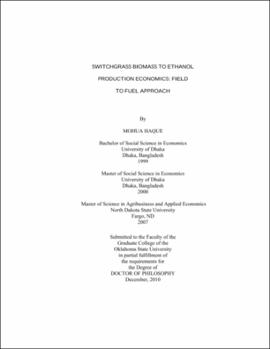| dc.contributor.advisor | Epplin, Francis M. | |
| dc.contributor.author | Haque, Mohua | |
| dc.date.accessioned | 2013-11-26T08:22:00Z | |
| dc.date.available | 2013-11-26T08:22:00Z | |
| dc.date.issued | 2010-12 | |
| dc.identifier.uri | https://hdl.handle.net/11244/6515 | |
| dc.description.abstract | Scope and Method of Study: Switchgrass has been proposed as a dedicated energy crop. The first essay determines switchgrass yield response to nitrogen fertilizer for a single annual harvest in July and for a single annual harvest in October based on a field experiments conducted at Stillwater, OK. Data were fitted to several functional forms to characterize both the July harvest and the October harvest response functions. Extending the harvest window to take advantage of reduction in harvest machinery investment costs has important biological consequences. The second essay determines the cost to deliver a ton of switchgrass biomass to a 2,000 tons per day plant located in Oklahoma. The model accounts for differences in yield and nitrogen fertilizer requirements across harvest months. The data were incorporated into a multi-region, multi-period, monthly time-step, mixed integer mathematical programming model that was constructed to determine the optimal strategy. Desirable feedstock properties, biomass to biofuel conversion rate, and investment required in plant differs depending on which conversion technology is used. The third essay determines the breakeven ethanol price for a cellulosic biorefinery. A comprehensive mathematical programming model that encompasses the chain from land acquisition to ethanol production was constructed and solved. | |
| dc.description.abstract | Findings and Conclusions: The July and October harvest plateau yield of 4.36 and 5.49 tons per acre were achieved with an estimated annual nitrogen fertilizer application of 80 and 63 pounds per acre, respectively. Farm gate production costs were estimated to be 60 per ton for the July harvest and 50 per ton for the October harvest. Based on the model results, the strategy of extending harvest over many months is economically preferable to a strategy of harvesting only in peak yield harvest months. Restricting harvest to a two-month harvest season would increase the cost to deliver feedstock by 23 percent. For a capital requirement of 400 million for a 100 million gallons per year biorefinery and a conversion rate of 100 gallons of ethanol per dry ton, the breakeven ethanol price is 1.93 per gallon. Biomass to ethanol conversion rate and the cost of biorefinery construction, operation, and maintenance are critical issues in the determination of the cost of producing ethanol from switchgrass. | |
| dc.format | application/pdf | |
| dc.language | en_US | |
| dc.rights | Copyright is held by the author who has granted the Oklahoma State University Library the non-exclusive right to share this material in its institutional repository. Contact Digital Library Services at lib-dls@okstate.edu or 405-744-9161 for the permission policy on the use, reproduction or distribution of this material. | |
| dc.title | Switchgrass biomass to ethanol production economics: Field to fuel approach | |
| dc.contributor.committeeMember | Stoecker, Arthur | |
| dc.contributor.committeeMember | Devuyst, Eric Allen | |
| dc.contributor.committeeMember | Huhnke, Raymond Leroy | |
| osu.filename | Haque_okstate_0664D_11119.pdf | |
| osu.accesstype | Open Access | |
| dc.type.genre | Dissertation | |
| dc.type.material | Text | |
| dc.subject.keywords | biomass | |
| dc.subject.keywords | ethanol | |
| dc.subject.keywords | mixed integer model | |
| dc.subject.keywords | production economics | |
| dc.subject.keywords | response function | |
| dc.subject.keywords | switchgrass | |
| thesis.degree.discipline | Agricultural Economics | |
| thesis.degree.grantor | Oklahoma State University | |
